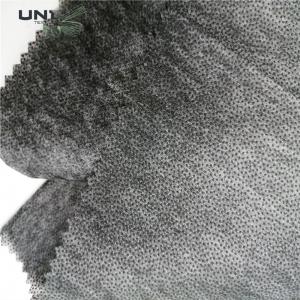

Add to Cart
Chemical Bond / Gum Stay Non-Woven Fabric 1025HF 1035HF 1040HF 1050HF 1070HF
Hot rolling is the last net forming technology in the production process of non-woven fabrics. It is a process to achieve fabric after cooling and wire laying. Hot rolling has high heat (100 ~ 150 degrees · the rolling wheel rolls the uniform fiber to melt and form a net. Therefore, there will be rolling points on the cloth surface of hot-rolled non-woven fabrics, which are similar to pinholes, but do not penetrate. The specific size depends on the size and density of the steel thorns on the rolling wheel[ Br /] to sum up, as a process, hot-rolled non-woven fabric is not a specific kind of fabric, but the general name of a kind of non-woven fabric formed by similar processes.
Generally speaking, spunbonded polypropylene non-woven fabric (PP), polyester non-woven fabric (PET), PA and nylon (PA) are used for hot-rolled treatment. The biggest difference between these three types is the difference of processing raw materials.
Main raw materials
(1) natural fiber: cotton, wool, hemp and silk;
(2) conventional fibers: viscose fiber, polyester fiber, acetate
fiber, polypropylene fiber and polyamide fiber;
(3) differentiated fiber: superfine fiber, profiled fiber, low
melting point fiber, high crimp fiber and antistatic fiber;
(4) high functional fiber: aromatic polyamide fiber, carbon fiber
and metal fiber.
Characteristic
Non woven fabrics can have many characteristics and distinguishing properties, such as non entangled edges and unique fiber orientation in fabrics.
They can be soft or hard, strong or weak, directional and omnidirectional in performance, have one or both smooth or uneven, provide bulk or very compact, two or three dimensions, solid or patterned openings, absorbent or repulsive and porous puncture.
Many of these features can be combined in one receipt to meet an end use product. Nonwovens can be elongated, stretched and recovered with a specific aperture, but can not be drawn, which is a very important difference between nonwovens and textile fabrics
In addition, they can provide excellent substrates for coatings, composites, lamination, printing, embossing and forming, so they are often used in packaging materials. Relatively speaking, the cost of non-woven fabrics as packaging materials is more expensive than ordinary packaging cartons, which is also the reason why they are not widely used. If non-woven fabric manufacturers want to fully open this big market, Reducing costs and taking the green route is undoubtedly the biggest challenge.
Overview |
